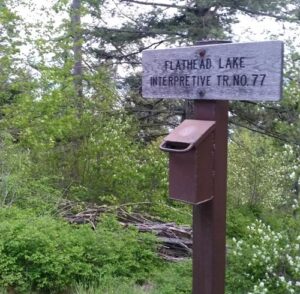 Flathead Lake is the largest natural freshwater lake in the western United States. Lying in the Flathead Valley of Northwest Montana, the lake is more then 300 feet deep and extends north and south some 28 miles and is seven to 15 miles wide.
Flathead Lake is the largest natural freshwater lake in the western United States. Lying in the Flathead Valley of Northwest Montana, the lake is more then 300 feet deep and extends north and south some 28 miles and is seven to 15 miles wide.
As you drive and drive on the roads that hug Flathead Lake’s shoreline, (US Highway 93 on the west and Montana Route 35 on the east) it’s hard to believe manmade dams that are so common in the Pacific Northwest didn’t create it. Rather, the lake is a fortuitous product of the activity of ice-age glaciers, and is fed by the Swan and Flathead Rivers.
All manner of water sports are enjoyed upon its 200 square miles of surface. Several state parks and lakeshore communities have boat launches and marinas on the Lake.
 You can avail yourself of a boat tour or rent one of the many types of watercraft including canoes, kayaks, windsurfers, hydro bikes, sailing and fishing boats. Serious anglers can arm themselves with heavy-duty equipment and probe the 300-foot deep Flathead Lake for trophy Mackinaw. Lake trout, salmon, perch, pike, bass, and whitefish are found in the Flathead area’s many lakes.
You can avail yourself of a boat tour or rent one of the many types of watercraft including canoes, kayaks, windsurfers, hydro bikes, sailing and fishing boats. Serious anglers can arm themselves with heavy-duty equipment and probe the 300-foot deep Flathead Lake for trophy Mackinaw. Lake trout, salmon, perch, pike, bass, and whitefish are found in the Flathead area’s many lakes.
Locals know summer has arrived when a steady stream of traffic starts to build on the secondary roads. So in peak season expect to share your enjoyment of the Flathead Valley with many others, although the mountains still offer room to get-away if you are willing to exert yourself.

 Photography and wildlife observation are encouraged. Waterfowl numbers vary throughout the year. There may be as many as 80,000 in October and November, and half that number in late March and through early May. A few ducks and geese may spend the winter. Nesting begins in late March and lasts through July. The most numerous nesting species are Canada geese, mallards, and redheads. Pintail, American widgeon, shoveler, blue and green-winged teal, ruddy duck, gadwall, common merganser, and coot are also present. Other species of water, marsh, and upland birds are abundant from May to October. Common loons are occasionally seen and this is a good area to see Bald Eagles.
Photography and wildlife observation are encouraged. Waterfowl numbers vary throughout the year. There may be as many as 80,000 in October and November, and half that number in late March and through early May. A few ducks and geese may spend the winter. Nesting begins in late March and lasts through July. The most numerous nesting species are Canada geese, mallards, and redheads. Pintail, American widgeon, shoveler, blue and green-winged teal, ruddy duck, gadwall, common merganser, and coot are also present. Other species of water, marsh, and upland birds are abundant from May to October. Common loons are occasionally seen and this is a good area to see Bald Eagles. Fees are charged during the summer (mid-May to late October). The Range is part of the U.S. Fee System and accepts Golden Passes and Federal Waterfowl Stamps. Pay fees at the Visitor Center. Camping is not allowed and the Range is closed at night.
Fees are charged during the summer (mid-May to late October). The Range is part of the U.S. Fee System and accepts Golden Passes and Federal Waterfowl Stamps. Pay fees at the Visitor Center. Camping is not allowed and the Range is closed at night.